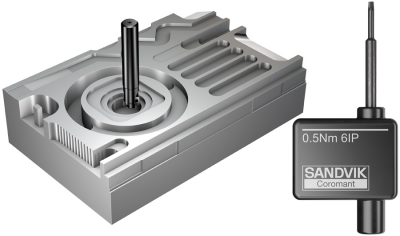
Sandvik Coromant recently introduced a new endmill for small diameters, the CoroMill 390 with size 07 inserts is said to be a versatile cutter ideal for shoulder milling, deep shoulder milling, edging, linear and helical ramping, plunge milling, slot milling and face milling, according to the company.
Suitable for all machine types, the CoroMill 390 with size 07 inserts also is said to be suitable for mixed production and can be used with different materials and applications.
Grades for the CoroMill 390 with size 07 inserts are available for all of materials. The new insert grade GC1130, produced with Zertivo technology, reportedly gives this cutter an extra dimension of security when milling steel. The smaller inserts deliver higher cutter-teeth density for superior productivity, according to Sandvik.
Unique to this tool is a torque key that’s specifically designed for size 07 inserts. The key, which has built-in spring functionality, allows users to mount inserts with the correct clamping force for reliable and consistent tool life. In addition, coolant-through technology is standard on the CoroMill 390 with size 07 inserts for additional heat and chip control.
Contact Details
Related Glossary Terms
- endmill
endmill
Milling cutter held by its shank that cuts on its periphery and, if so configured, on its free end. Takes a variety of shapes (single- and double-end, roughing, ballnose and cup-end) and sizes (stub, medium, long and extra-long). Also comes with differing numbers of flutes.
- gang cutting ( milling)
gang cutting ( milling)
Machining with several cutters mounted on a single arbor, generally for simultaneous cutting.
- milling
milling
Machining operation in which metal or other material is removed by applying power to a rotating cutter. In vertical milling, the cutting tool is mounted vertically on the spindle. In horizontal milling, the cutting tool is mounted horizontally, either directly on the spindle or on an arbor. Horizontal milling is further broken down into conventional milling, where the cutter rotates opposite the direction of feed, or “up” into the workpiece; and climb milling, where the cutter rotates in the direction of feed, or “down” into the workpiece. Milling operations include plane or surface milling, endmilling, facemilling, angle milling, form milling and profiling.
- plunge milling
plunge milling
Highly productive method of metal removal in which an axial machining operation is performed in a single tool sequence. The tool makes a series of overlapping, drill-like plunges to remove part of a cylindrical plug of material one after another. Because of the increased rigidity of a Z-axis move, the tool can cover a large cross-section of material.







